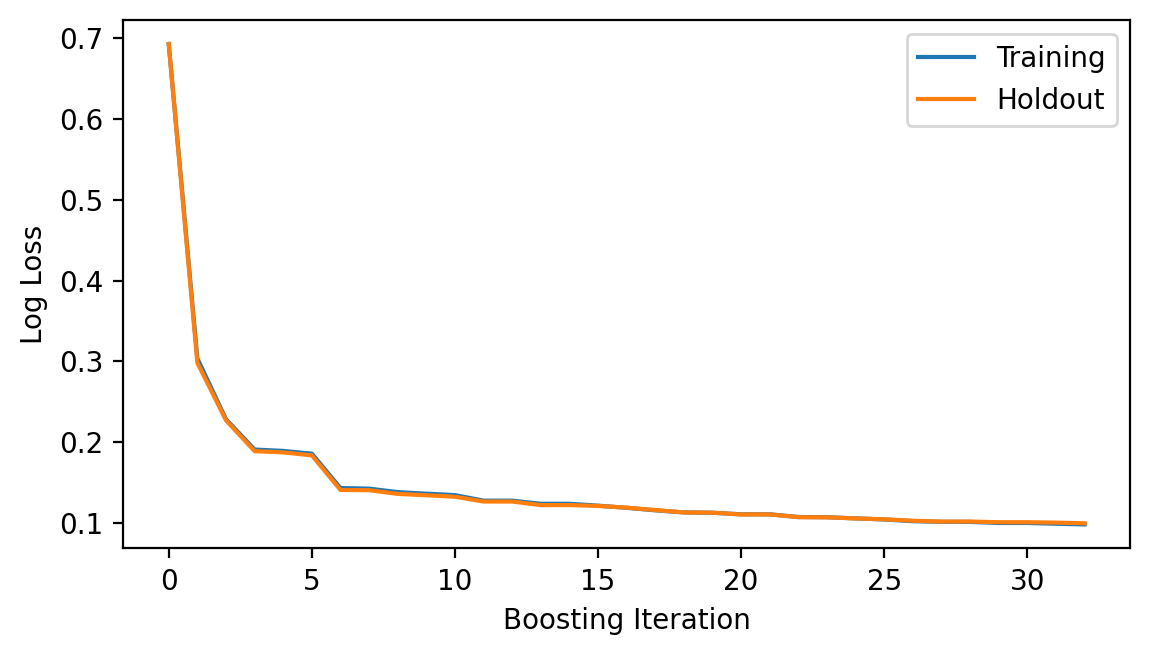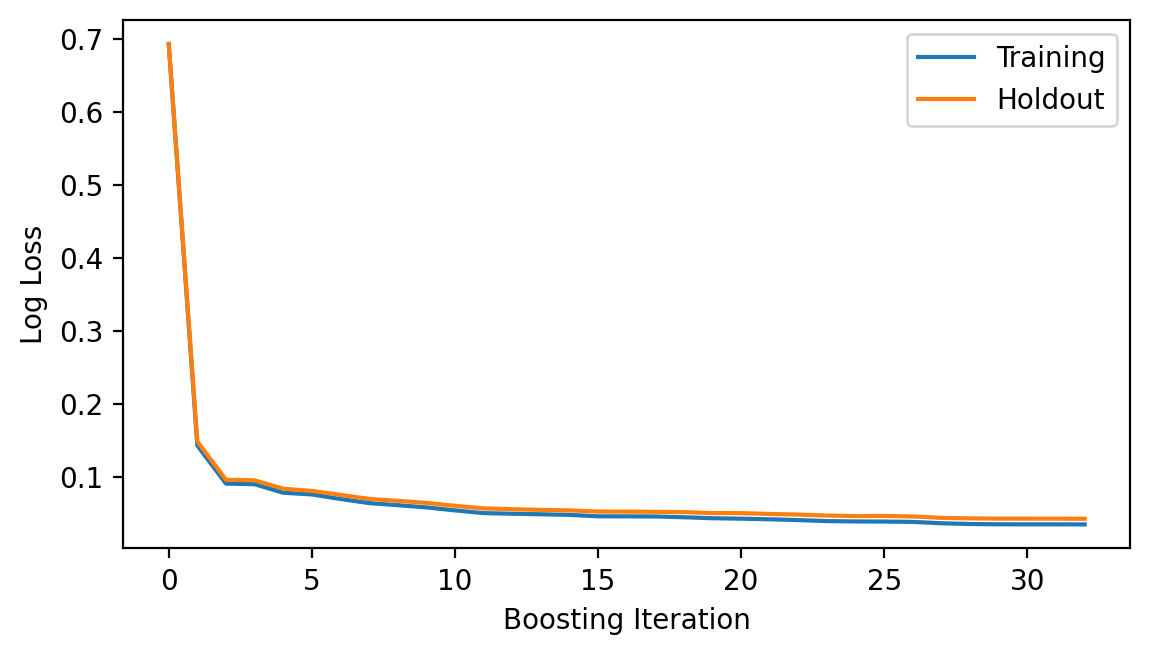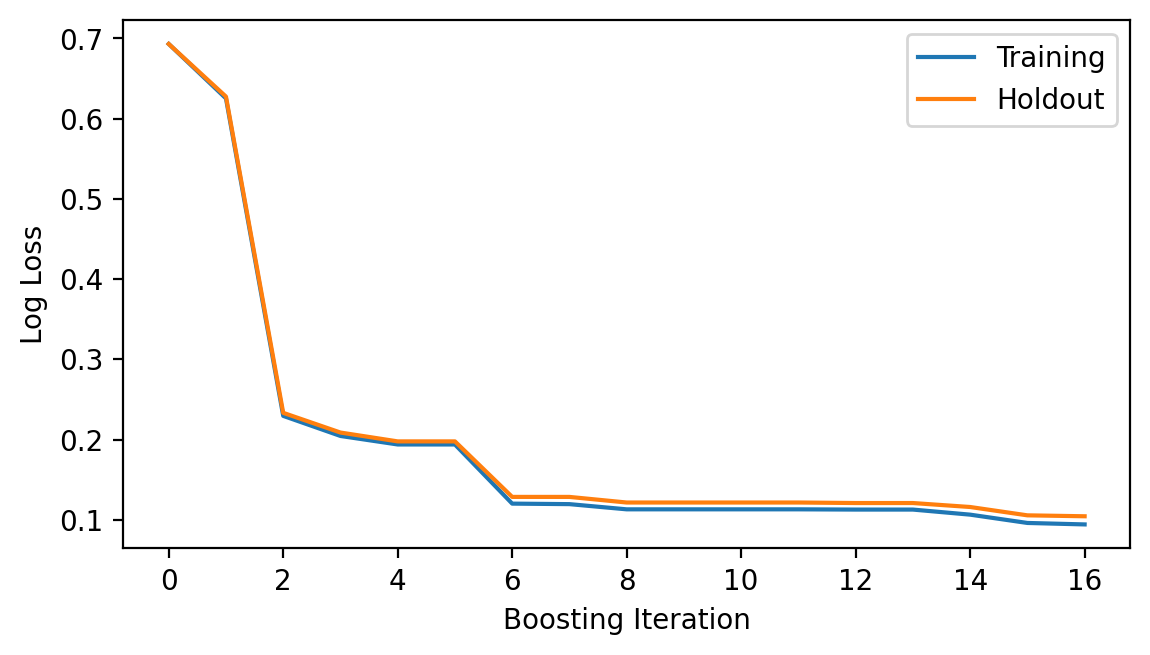Forward-Propagating Neural Network Example¶
This example demonstrates building a neural network in a forward,
greedy manner. The code below utilizes pytorch, with the version
listed under imports. pytorch is not included in the genestboost
‘setup.py’ file and must be installed separately. The dataset used to
demonstrate will be the MNIST dataset. pytorch will be used to
implement a convolutional neural network. As multivariate targets are
not yet supported, the problem solved will be to predict a binary target
- here, the digit 5 is arbitrarily chosen as the positive target
class. Any other digit is in the ‘other’ class.
The main thing to be aware of in going through the example is that
pytorch utilizes its own tensor type under the hood, while
genestboost performs calculations using numpy arrays. Switching
between the two is easy using torch.numpy or torch.from_numpy,
but getting this right in all the right places can be tricky and may be
the source of bugs. Getting input and output sizes correct in advancing
layers can be tricky as well.
In the code that follows, three layers are built manually: two convolutional layers and one dense layer. After that, final dense layer is trained using pytorch that creates the final output. With a little creativity, subclassing, and some elbow grease, the process could be automated. Due to a lack of computing power on the machine for which this example is being run, the number of layers has been constrained. But you could imagine training larger and/or more layers. Again, when viewing final metrics, please keep in mind that no tuning has been performed. The calculations are purely for demonstration purposes.
import warnings
import random
import numpy as np
from functools import partial
from sklearn.metrics import roc_auc_score
import matplotlib.pyplot as plt
import torch
import torch.nn as nn
import torchvision
import torchvision.datasets as datasets
from genestboost import BoostedModel
from genestboost.loss_functions import LogLoss
from genestboost.link_functions import LogitLink
%matplotlib inline
print("pytorch version: {:s}".format(torch.__version__))
pytorch version: 1.8.1
torch.manual_seed(17) # set torch seed
np.random.seed(17) # set numpy seed
pytorch Model Training Loop Helper¶
def training_loop(n_epochs, optimizer, model, loss_fn, train_loader, tol=1e-6):
"""Train a pytorch `model`."""
for epoch in range(1, n_epochs + 1):
for imgs, labels in train_loader:
outputs = model(imgs)
loss = loss_fn(outputs, labels)
optimizer.zero_grad()
loss.backward()
optimizer.step()
# for the example layers, let's use 1 epoch, ADAM, and logloss at each boosted iteration
# we will use these parameters for other layers as well
example_trainer = partial(
training_loop,
n_epochs=1,
loss_fn=nn.MSELoss(), # remember each boosting iteration trains a regression nn.CrossEntropyLoss()
)
pytorch Custom Dataset class¶
A simple class that takes the familiar X, y sklearn style matrices
here is used to interface with pytorch for purposes of model
training. The class does nothing more than take the X and y matrices and
implement magic methods for __len__ and __getitem__ as
recommended in the pytorch API.
class NumpyDataset(torch.utils.data.Dataset):
"""A custom Dataset class to for use with training pytorch layers by boosting."""
def __init__(self, X, y, target_type=torch.float32):
self._data = torch.from_numpy(X).to(torch.float32).unsqueeze(1)
self._targets = torch.from_numpy(y).to(target_type)
if self._data.shape[0] != self._targets.shape[0]:
raise AttributeError("X and y must have the same shape[0] entry")
def __len__(self):
return self._data.shape[0]
def __getitem__(self, ndx):
return (self._data[ndx], self._targets[ndx])
Load MNIST data¶
Here, we load the MNIST dataset from torchvision.datasets and create
a binary target for the number 5. genestboost does not yet have
support for multivariate target boosting.
# # download MNIST data
# with warnings.catch_warnings():
# warnings.simplefilter("ignore")
# _ = datasets.MNIST(root='./data', train=True, download=True, transform=None)
# _ = datasets.MNIST(root='./data', train=False, download=True, transform=None)
# load data
mnist_train = datasets.MNIST(root='./data', train=True, transform=None)
mnist_test = datasets.MNIST(root='./data', train=False, transform=None)
# X, y - let's create a binary target for the number 5
X_train = mnist_train.data
y_train = torch.where(mnist_train.targets == 5, 1, 0)
X_test = mnist_test.data
y_test = torch.where(mnist_test.targets == 5, 1, 0)
Sample Positive Targets¶
# sample 5 image
fig, axes = plt.subplots(1, 10)
fig.set_figheight(4)
fig.set_figwidth(20)
for i in range(10):
ax = axes[i]
ax.imshow(X_train[y_train == 1][i], cmap=plt.get_cmap("gray_r"));

Sample Negative Targets¶
# sample non-5 image
fig, axes = plt.subplots(1, 10)
fig.set_figheight(4)
fig.set_figwidth(20)
for i in range(10):
ax = axes[i]
ax.imshow(X_train[y_train == 0][i], cmap=plt.get_cmap("gray_r"));

Target rate, image size, and mean/std calculation¶
# target incidence in training set
y_train.to(torch.float32).mean().item()
0.09035000205039978
# image size
X_train[0].shape
torch.Size([28, 28])
# image means and std for normalization
train_mean = X_train.to(torch.float32).mean()
train_std = X_train.to(torch.float32).std()
CNN Weak Learner - Initial Layer¶
For the initial boosted layer, let’s use a convolutional net, with a
single convolution in each linear that downsizes to a 32-unit dense
layer before making the final class prediction. Arbitrarily, tanh
activations are used.
class NetL1(nn.Module):
def __init__(self):
super().__init__()
self.conv1 = nn.Conv2d(1, 1, kernel_size=3, padding=1)
self.act1 = nn.Tanh()
self.dense2 = nn.Linear(28 * 28, 1)
def forward(self, X):
# normalize the inputs with training set image means and std
out = torchvision.transforms.functional.normalize(X, train_mean, train_std)
# network modules
out = self.conv1(X)
out = self.act1(out)
out = out.view(-1, 28 * 28)
out = self.dense2(out).flatten()
return out
That is the learner, now let’s wrap it in a class with fit and predict methods.
class NetL1Wrapper:
"""Wrapper for NetL1 class for use in BoostedModel."""
def __init__(self, training_epochs=5, lr=0.01, random_state=0):
self._model = None # attribute to store the NN
self._epochs = training_epochs
self._lr = lr
random.seed(random_state)
def fit(self, X, y, weights=None):
self._model = NetL1()
self._initialize_weights()
optimizer = torch.optim.Adam(lr=self._lr, params=self._model.parameters())
train_loader = torch.utils.data.DataLoader(
NumpyDataset(X, y),
batch_size=32,
shuffle=True,
)
example_trainer(
model=self._model,
train_loader=train_loader,
optimizer=optimizer
)
# set model attribute and return self
return self
def predict(self, X):
with torch.no_grad():
Xt = torch.from_numpy(X).to(torch.float32).unsqueeze(1)
outputs = self._model(Xt).squeeze().numpy()
return outputs
def _initialize_weights(self):
with torch.no_grad():
self._model.apply(self.init_weights)
@staticmethod
def init_weights(layer):
if type(layer) != NetL1 and hasattr(layer, "weight"):
torch.nn.init.xavier_uniform_(layer.weight)
layer.bias.data.fill_(0.01)
Boost Units that will Build the First Layer¶
model = BoostedModel(
link=LogitLink(),
loss=LogLoss(),
model_callback=NetL1Wrapper,
alpha=5.0,
step_type="best",
init_type="zero",
validation_fraction=0.20,
validation_iter_stop=10,
validation_stratify=True,
)
model.fit(X_train.numpy(), y_train.to(torch.float32).numpy(), iterations=32);
fig = plt.figure(figsize=(6.5, 3.5), dpi=200)
ax = fig.add_subplot(111)
ax.plot(model.get_loss_history(), label=["Training", "Holdout"])
ax.set_ylabel("Log Loss")
ax.set_xlabel("Boosting Iteration")
ax.legend(loc="best");

model.get_iterations() # number of out channels for the first layer
32
Build the first layer¶
Let’s build the first layer, a single layer of convolutions, by
extracting the boosted convolutional weights from each model iteration.
To do this, we will access the “private” _model_list attribute of
the underlying BoostedModel class. This goes against convention -
however, access to the individual models will be exposed in version 1.0.
Below, we create a new pytorch module that is the same as the
boosted model with a few key differences: * The number of channels to
the convolutional layer has been changed to match the number of boosting
iterations in the boosted model above; and * The dense layer and its
associated input transformation inside of the module forward method
have been removed.
After the module class has been created, we will aggregate the weights from the boosted model convolutional layer , set the weights of the new module, and then use the module to create inputs for the next planned network layer.
weights = (
torch
.stack([m._model.conv1.weight for m, _ in model._model_list])
.reshape((-1, 1, 3, 3))
)
bias = torch.stack([m._model.conv1.bias for m, _ in model._model_list]).squeeze()
num_channels_1 = model.get_iterations()
class Module1(nn.Module):
def __init__(self, num_channels):
super().__init__()
self.conv1 = nn.Conv2d(1, num_channels, kernel_size=3, padding=1)
self.act1 = nn.Tanh()
def forward(self, X):
# normalize the inputs with training set image means and std
out = torchvision.transforms.functional.normalize(X, train_mean, train_std)
# network modules
out = self.conv1(X)
out = self.act1(out)
return out
# set the weights from our first round of boosting
mod1 = Module1(num_channels_1)
mod1.conv1.weight = torch.nn.Parameter(weights)
mod1.conv1.bias = torch.nn.Parameter(bias)
Build the second layer¶
Now let’s create the second layer (module) and wrapper for use in
genestboost. Without questioning, we will build a module to perform
a 2x2 max pool (MNIST data has a black background) with stride 2,
followed by another 3x3 convolutional layer. We will use mod1 under
a torch.no_grad context so that the weights remain static. This
allows use to make the same BoostedModel call above without having
to worry about re-creating inputs at each new layer.
class NetL2(nn.Module):
def __init__(self, channels_in):
super().__init__()
self.conv1 = nn.Conv2d(channels_in, 1, kernel_size=3, padding=1)
self.act1 = nn.Tanh()
self.dense2 = nn.Linear(14 * 14, 1) # max pooling will cut size in half
def forward(self, X):
# send the input through our first layer here
with torch.no_grad():
out = mod1(X)
# perform second layer calculations here
out = nn.functional.max_pool2d(out, kernel_size=2, stride=2) # max pooling
out = self.conv1(out)
out = self.act1(out)
out = out.view(-1, 14 * 14)
out = self.dense2(out).flatten()
return out
class NetL2Wrapper:
"""Wrapper for NetL2 for use in the BoostedModel class."""
def __init__(self, channels_in, training_epochs=5, lr=0.01, random_state=0):
self._channels_in = channels_in
self._model = None # attribute to store the NN
self._epochs = training_epochs
self._lr = lr
random.seed(random_state)
def fit(self, X, y, weights=None):
self._model = NetL2(self._channels_in)
self._initialize_weights()
optimizer = torch.optim.Adam(lr=self._lr, params=self._model.parameters())
train_loader = torch.utils.data.DataLoader(
NumpyDataset(X, y),
batch_size=32,
shuffle=True,
)
example_trainer(
model=self._model,
train_loader=train_loader,
optimizer=optimizer
)
# set model attribute and return self
return self
def predict(self, X):
with torch.no_grad():
Xt = torch.from_numpy(X).to(torch.float32).unsqueeze(1)
outputs = self._model(Xt).squeeze().numpy()
return outputs
def _initialize_weights(self):
with torch.no_grad():
self._model.apply(self.init_weights)
@staticmethod
def init_weights(layer):
if type(layer) != NetL2 and hasattr(layer, "weight"):
torch.nn.init.xavier_uniform_(layer.weight)
layer.bias.data.fill_(0.0)
model = BoostedModel(
link=LogitLink(),
loss=LogLoss(),
model_callback=NetL2Wrapper,
model_callback_kwargs={"channels_in": num_channels_1},
alpha=5.0,
step_type="best",
init_type="zero",
validation_fraction=0.20,
validation_iter_stop=10,
validation_stratify=True,
)
model.fit(X_train.numpy(), y_train.numpy(), iterations=32);
fig = plt.figure(figsize=(6.5, 3.5), dpi=200)
ax = fig.add_subplot(111)
ax.plot(model.get_loss_history(), label=["Training", "Holdout"])
ax.set_ylabel("Log Loss")
ax.set_xlabel("Boosting Iteration")
ax.legend(loc="best");

model.get_iterations()
32
Below, we once again will store the weights from the second layer and
create a second module. The second module will give us the output from
the first two layers and will be used internally in building layer three
to get inputs so that once gain, we can make the same call to
BoostedModel, only having to change the model_callback and
model_callback_kwargs.
weights = (
torch
.stack([m._model.conv1.weight for m, _ in model._model_list])
.reshape((-1, 32, 3, 3))
)
bias = torch.stack([m._model.conv1.bias for m, _ in model._model_list]).squeeze()
num_channels_2 = model.get_iterations()
class Module2(nn.Module):
def __init__(self, channels_in, channels_out):
super().__init__()
self.conv1 = nn.Conv2d(channels_in, channels_out, kernel_size=3, padding=1)
self.act1 = nn.Tanh()
def forward(self, X):
# send the input through our first layer here
with torch.no_grad():
out = mod1(X)
# perform second layer calculations here
out = nn.functional.max_pool2d(out, kernel_size=2, stride=2) # max pooling
out = self.conv1(out)
out = self.act1(out)
return out
# set the weights from our first round of boosting
mod2 = Module2(num_channels_1, num_channels_2)
mod2.conv1.weight = torch.nn.Parameter(weights)
mod2.conv1.bias = torch.nn.Parameter(bias)
Build the final, dense layer¶
Repeat the above process for the final dense layer.
class NetL3(nn.Module):
def __init__(self):
super().__init__()
self.dense1 = nn.Linear(32 * 14 * 14, 1)
def forward(self, X):
# send the input through our first two layers (mod1 and mod2) here
# remember that mod2 contains mod1
with torch.no_grad():
out = mod2(X) # remember that mod2 contains mod1
# perform third layer calculations here
out = out.view(-1, 14 * 14 * 32)
out = self.dense1(out).flatten()
return out
class NetL3Wrapper:
def __init__(self, training_epochs=5, lr=0.01, random_state=0):
self._model = None # attribute to store the NN
self._epochs = training_epochs
self._lr = lr
random.seed(random_state)
def fit(self, X, y, weights=None):
self._model = NetL3()
self._initialize_weights()
optimizer = torch.optim.Adam(lr=self._lr, params=self._model.parameters())
train_loader = torch.utils.data.DataLoader(
NumpyDataset(X, y),
batch_size=32,
shuffle=True,
)
example_trainer(
model=self._model,
train_loader=train_loader,
optimizer=optimizer
)
# set model attribute and return self
return self
def predict(self, X):
with torch.no_grad():
Xt = torch.from_numpy(X).to(torch.float32).unsqueeze(1)
outputs = self._model(Xt).squeeze().numpy()
return outputs
def _initialize_weights(self):
with torch.no_grad():
self._model.apply(self.init_weights)
@staticmethod
def init_weights(layer):
if type(layer) != NetL3 and hasattr(layer, "weight"):
torch.nn.init.xavier_uniform_(layer.weight)
layer.bias.data.fill_(0.0)
model = BoostedModel(
link=LogitLink(),
loss=LogLoss(),
model_callback=NetL3Wrapper,
model_callback_kwargs={},
alpha=5.0,
step_type="best",
init_type="zero",
validation_fraction=0.20,
validation_iter_stop=10,
validation_stratify=True,
)
model.fit(X_train.numpy(), y_train.numpy(), iterations=16);
fig = plt.figure(figsize=(6.5, 3.5), dpi=200)
ax = fig.add_subplot(111)
ax.plot(model.get_loss_history(), label=["Training", "Holdout"])
ax.set_ylabel("Log Loss")
ax.set_xlabel("Boosting Iteration")
ax.legend(loc="best");

Putting it all together in a single network¶
We could use the last prediction as is - a boosted ensemble of convolutional neural networks that was trained one convolutional layer at a time. Just for fun, though, let’s build a final model that is a single neural network.
To do this, we first create module three, a pytorch network of our
layers thus far, then optimize the final output using pytorch. Since
we are using pytorch directly here, the final dense output layer
will be trained as a classifier with two outputs. CrossEntropyLoss
will be used - this will automatically log-softmax the two outputs in
the loss calculation. Note that this needs to be done manually on the
final predictions if the intent is to convert to probabilities.
weights = (
torch
.stack([m._model.dense1.weight for m, _ in model._model_list])
.squeeze(1)
)
bias = torch.stack([m._model.dense1.bias for m, _ in model._model_list]).squeeze()
class Module3(nn.Module):
"""Module3 - note the 16 channels out corresponding to the boosting iterations above."""
def __init__(self):
super().__init__()
self.dense1 = nn.Linear(32 * 14 * 14, 16)
def forward(self, X):
# send the input through our first two layers (mod1 and mod2) here
# remember that mod2 contains mod1
with torch.no_grad():
out = mod2(X)
# perform third layer calculations here
out = out.view(-1, 14 * 14 * 32)
out = self.dense1(out)
return out
# set the weights from our first round of boosting
mod3 = Module3()
mod3.dense1.weight = torch.nn.Parameter(weights)
mod3.dense1.bias = torch.nn.Parameter(bias)
class FinalNet(nn.Module):
def __init__(self):
super().__init__()
self.dense1 = nn.Linear(16, 2) # output for each class
def forward(self, X):
with torch.no_grad():
out = mod3(X) # remember that mod2 contains mod1
out = self.dense1(out)
return out
# create and train the model for an epoch
final_model = FinalNet()
train_loader = torch.utils.data.DataLoader(
NumpyDataset(X_train.numpy(), y_train.numpy(), target_type=torch.long),
batch_size=32,
shuffle=True,
)
training_loop(
n_epochs=1,
optimizer=torch.optim.Adam(lr=0.01, params=final_model.parameters()),
model=final_model,
loss_fn=nn.CrossEntropyLoss(),
train_loader=train_loader
)
Evaluate Train and Test Error¶
final_model.eval() # set model in eval mode
train_preds = final_model(X_train.to(torch.float32).unsqueeze(1))
train_preds = nn.functional.softmax(train_preds, dim=1)[:, 1].detach().numpy()
test_preds = final_model(X_test.to(torch.float32).unsqueeze(1))
test_preds = nn.functional.softmax(test_preds, dim=1)[:, 1].detach().numpy()
train_roc = roc_auc_score(y_train.numpy(), train_preds)
train_accuracy = np.sum((y_train.numpy() == 1) == (train_preds > 0.5)) / train_preds.shape[0]
test_roc = roc_auc_score(y_test.numpy(), test_preds)
test_accuracy = np.sum((y_test.numpy() == 1) == (test_preds > 0.5)) / test_preds.shape[0]
print("Training set:")
print(" ROCAUC: {:.3f}".format(train_roc))
print(" Accuracy: {:.3f}".format(train_accuracy))
print()
print("Test set:")
print(" ROCAUC: {:.3f}".format(test_roc))
print(" Accuracy: {:.3f}".format(test_accuracy))
Training set:
ROCAUC: 0.990
Accuracy: 0.981
Test set:
ROCAUC: 0.985
Accuracy: 0.980